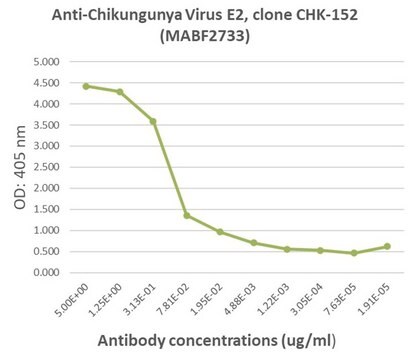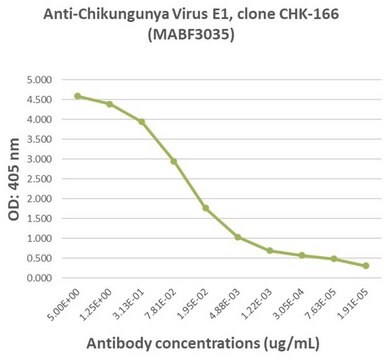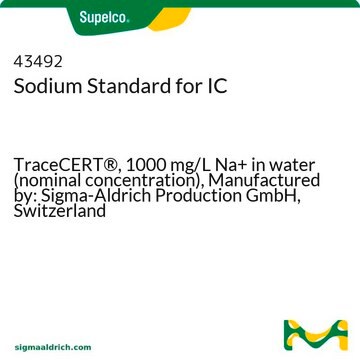MABF2052
Anti-Chikungunya virus Antibody, clone 3E7b
clone 3E7b, from mouse
Synonym(e):
CHIKV
About This Item
Empfohlene Produkte
Biologische Quelle
mouse
Antikörperform
purified immunoglobulin
Antikörper-Produkttyp
primary antibodies
Klon
3E7b, monoclonal
Speziesreaktivität
virus
Verpackung
antibody small pack of 25 μL
Methode(n)
ELISA: suitable
immunocytochemistry: suitable
neutralization: suitable
western blot: suitable
Isotyp
IgMκ
Posttranslationale Modifikation Target
unmodified
Allgemeine Beschreibung
Spezifität
Immunogen
Anwendung
Entzündung & Immunologie
Immunocytochemistry Analysis: A representative lot detected Chikungunya virus in Immunocytochemistry applications (Lam, S., et. al. (2015). MAbs. 7(6):1178-94).
Immunocytochemistry Analysis: A 1:100 dilution from a representative lot detected Chikungunya virus in BHK cells infected with Chikungunya virus. (Courtesy from an independent lab).
Neutralizing Analysis: A representative lot neutralized Chikungunya virus in Neutralizing applications (Lam, S., et. al. (2015). MAbs. 7(6):1178-94).
ELISA Analysis: A representative lot detected Chikungunya virus in ELISA applications (Lam, S., et. al. (2015). MAbs. 7(6):1178-94).
Qualität
Isotype Analysis: The identity of this monoclonal antibody is confirmed by isotype test to be mouse IgMk.
Physikalische Form
Lagerung und Haltbarkeit
Sonstige Hinweise
Haftungsausschluss
Not finding the right product?
Try our Produkt-Auswahlhilfe.
Analysenzertifikate (COA)
Suchen Sie nach Analysenzertifikate (COA), indem Sie die Lot-/Chargennummer des Produkts eingeben. Lot- und Chargennummern sind auf dem Produktetikett hinter den Wörtern ‘Lot’ oder ‘Batch’ (Lot oder Charge) zu finden.
Besitzen Sie dieses Produkt bereits?
In der Dokumentenbibliothek finden Sie die Dokumentation zu den Produkten, die Sie kürzlich erworben haben.
Unser Team von Wissenschaftlern verfügt über Erfahrung in allen Forschungsbereichen einschließlich Life Science, Materialwissenschaften, chemischer Synthese, Chromatographie, Analytik und vielen mehr..
Setzen Sie sich mit dem technischen Dienst in Verbindung.







